#Semiaquatic Rodent
Explore tagged Tumblr posts
Video
A Muskrat “Enjoying” a Morning Swim on a Nearby Kettle Pond in Denali National Park & Preserve by Mark Stevens Via Flickr: While on a bus ride from the North Face Lodge along the main park road in Denali National Park & Preserve. This was a view looking to the northeast not too far after passing Wonder Lake.
#Alaska 2019#Alaska Range#Alaska-Yukon Ranges#Azimuth 31#Bus Ride from North Face Lodge#Day 11#Denali National Park#Denali National Park & Preserve#Denali National Park Rd#Denali National Park and Preserve#DxO PhotoLab 3 Edited#Image Capture With Arsenal#Kettle Pond#Lake#Landscape#Landscape - Scenery#Looking NE#Muskrat#Nature#Nikon D800E#No People#Ondatra zibethicus#Outside#Pond#Project365#Scenery - Nature#Semiaquatic Rodent#Swimming#Tundra#West-Central Alaska Range
1 note
·
View note
Text

Redbubble: Isai-64v16.redbubble.com Tumblr: isai-64v16 Twitter: @isai_64v16 Pinterest: https://pin.it/5I3nvjU Paypal me: paypal.me/Isai64v16
#capybara#mammal#rodent#herbivore#semiaquatic#social#glasses#fashion#elegance#fur#large#friendly#gregarious#ecofriendly#pixelart#art#redbubble
0 notes
Text

Semiaquatic rodents. And yes, they're blue, because i wanted them to have more relations to the water
Left to right: capybara, copyu, north american beaver and muskrat
(In case you don't know, these rodents have orange teeth)
0 notes
Text
Spectember/Spectober 2024 #10: Nosey Sea Monkey & Louse Mouse
Okay, let's finish up this year's round of speculative evolution concepts with one last post before we get back to normal paleoart content.
(…what do you mean it's November 3rd? how did that happen?)
Belial Lyka asked for a "marine proboscis monkey with a somewhat buoyant nose":

A descendant of modern proboscis monkeys, Phusarhinus beliallykae is a large semiaquatic primate found in shallow marshy coastal areas of what was once Southeast Asia. Around 4m long (~13') it has a lifestyle somewhat similar to ancient early sirenians, feeding on soft aquatic plants and hauling out onto land to rest.
Its dense rib bones and long flipper-like grasping forelimbs make it rather front-heavy, allowing it to naturally float with its head and arms hanging down closer to the bottom for energy-efficient foraging. When it needs to resurface to breathe it shunts air from its lungs into its large inflatable nasal sacs, altering its buoyancy enough to tip its head back up towards the surface.
Unlike its ancestors the elaborate nasal structures are found on both males and females – although they're more brightly colored in males and are also used for visual courtship displays and as resonating chambers for loud booming calls.
———
And somebody who only gave their name as "bunny" suggested a "parasitic rodent":

Sanguichelonamys bunnyi is a highly unusual descendant of a rakali-like semiaquatic rodent that had a symbiotic relationship with early members of the Phusarhinus lineage. The rodents initially just removed algae and external parasites from the bodies of the increasingly bulky aquatic monkeys, but things have recently started to turn more parasitic.
At just 3cm long (~1.2") Sanguichelonamys is one of the smallest mammals to ever exist, with a wide flattened body and sharp hooked claws used to cling onto its host monkey's thick skin. Although it still does remove other parasites, during haul-out periods it will also use its sharp incisors to deliberately enlarge the wounds left behind – or even open up new ones – and directly feed on fresh blood from its host.
The thickened keratinous skin along its head and back has a specialized hydrophobic surface that traps a layer of air while underwater, acting as a "rebreather" bubble similar to that of water anoles. Along with the ability to drastically slow down its metabolism and respiration rate, this allows Sanguichelonamys to survive being submerged during its host's lengthy foraging dives.
#spectober#spectember#spectember 2024#speculative evolution#cercopithecidae#old world monkey#primate#muridae#rodent#mammal#art#science illustration#and thus nix escapes from spechell for another year#see you tomorrow with our regular schedule
160 notes
·
View notes
Note
man your work is so cool- how'd you learn to draw so many different species? do you have a background in biology or anything like that?
Thanks. I probably have as much of a background in biology as anyone without an actual biology related degree or line of work can claim (lifelong obsession + volunteering + some classes + several biology residencies + tons of time in the outdoors) but not really
It's mostly the autism like I spend a lot of my time learning about a massive spectrum of Nature Related Topics and mostly read science nonfiction so I have a pretty solid knowledge foundation on which to realistically construct new things (same goes for ancient/pre-modern era history, same sort of shit). I've also been drawing animals all my life and have a probably? above average learned sense of how the anatomy of most groups work and how certain features work and etc (I've got a lot of weak points though like bird wings are difficult. Like I get how they're laid out but translating that accurately into how they look folded is kinda beyond me without referencing).
I do use references, usually not for poses (unless they're particularly difficult) but like to realistically translate a concept. If I have 'large semiaquatic rodent with a vertically flattened tail that spends a lot of time on land, feeds as a browser, chews and carries sticks to build a lodge, digs canals between waterways' as a concept, I'm referencing a variety of semiaquatic rodents in ways that make sense (it's going to be more cursorial than a beaver but probably not as much of a capybara, so it will still be plantigrade, it needs to have strong legs for digging, its tail should be fairly large to be the primary propelling limb in water but not large enough to severely impede land based momentum, it feeds more like a muskrat or beaver than a capybara so it's jaw orientation should be along those lines, it should have fairly highset eyes, ears, nostrils, its semi-aquatic and not a huge animal so it should have a solid fur coat to trap heat, but its environment is fairly warm year round so its coat should reflect that, etc). It's more of a complicated process if I'm doing something that wholly does not Exist (like we have plenty of semi-aquatic rodents but we do not have flightless aquatic pterosaurs) but same concept, just referencing things that exist to construct things that don't exist in a fairly believable manner.
#Like the specific process I use involves having a very solid background in How Things Work and then researching How Would This#Specific Idea Work#Shorter answer is: Wikipedia addiction#I've also already changed my mind on how the anara tail should have looked like its lower half should be connected lower on the abdomen#A little more crocodilian. This wouldn't impede motion much more but would make the tail stronger#Maybe even shorter but stiffer
39 notes
·
View notes
Text
the thing is that I have often been told that knitting things like socks and gloves is difficult, so I became afraid of actually trying to knit them.
but no one ever has said to me 'it's going to be hard to knit a large semiaquatic rodent,' so now I am knitting a beaver with comparative ease.
#today's art adventure#now I want to knit fingerless gloves and lace mitts and SOCKS#but also I do have to finish this beaver.
32 notes
·
View notes
Text
Wet Beast Wednesday: beavers
I love rodents; they're my favorite mammals. So today I'm combining rodents with the usual Wet Beast Wednesday to talk about beavers. These rodents are not only amphibious, they're engineers that play a major role in their ecosystems. Let's find out why you should appreciate beavers.

(Image ID: a beaver standing on dirt. It is a rotund, furry mammal with a large, blunt head. Its legs and eyes are small. Its tail is wide, flat, and hairless. It is wet. End ID)
There are two species of beaver: the North American beaver Castor canadensis and Eurasian beaver Castor fiber. The two species are so similar to each other in morphology and behavior that it took genetic testing to confirm that they are distinct species. Each species is divided into many subspecies, with a classified 25 for the North American beaver and 9 for the Eurasian beaver. Beavers are the second largest living rodents after the capybara. Adults have a body length of 80-120 cm (31-47 in), tail length of 25-50 cm (9.8-19.7 in) and usually weigh between 11 and 30 kg (24-66 lbs) but can reach up to 50 kg (110 lbs). Beavers are semiaquatic and have multiple adaptations for living in the water. The hind legs have webbed toes and are used to provide propulsion while swimming. The wide, flat, paddle-like tail is used as a rudder. Beaver fur is very thick, with 12,000 to 23,000 hairs per square centimeter and grows in multiple layers. The hair keeps the beaver warm and provides buoyancy while being thick enough to act as armor, protecting the beaver from predators. Beavers can hold their breath for up to 15 minutes, but most dives are shorter than that. While underwater, the beaver's heart rate is halved and blood is redirected to the brain and away from the extremities. The ears and nostrils can close underwater and the mouth can form a watertight seal. Being highly adapted for swimming, beavers are somewhat clumsy on land, but they can still move fast if needed. The front feet are very dextrous and can carry objects. Beavers can stand and move on their hind legs while holding things with their front feet. The tail helps provide stability while standing up. Like other rodents, beavers have an upper and lower pair of incisors that grow for their entire lives. The teeth need to be worn down by gnawing on objects and a beaver that can't gnaw can suffer from health problems as their incisors grow too big. Beaver teeth are coated with a layer of enamel that contains iron compounds, giving the incisors a characteristic orange color. The teeth grow outside the mouth and the beaver can close its lips while moving the teeth, letting it chew or pick thing up with its teeth underwater without getting water in its mouth. Unlike other rodents and pretty much every mammal, the beaver's excretory and reproductive tracts are merged into a single hole called the cloaca. Cloacas are common in reptiles, amphibians, etc, but having separate holes is a kay mammal trait. Beavers must have evolved back into having a cloaca. One hypothesis for why is that having a single hole reduced the surface area that can be exposed to the water, reducing the chance of infection. Males have a penis that extends from the cloaca when in use. Because of this, male and female beavers are virtually indistinguishable by sight if the penis is retracted. Staying downstairs, beavers have two sets of scent glands, anal glands and castor sacs. Both are used to produce scent chemicals that are used by beavers to mark their territory and identify each other. The anal glands also produce an oily substances that beaver groom into their fur to help waterproof it. The castor sacs produce a substance called castoreum and are attached to the urethra. Ancient people often thought that the castor sacs were testicles and that female beavers were actually hermaphrodites.
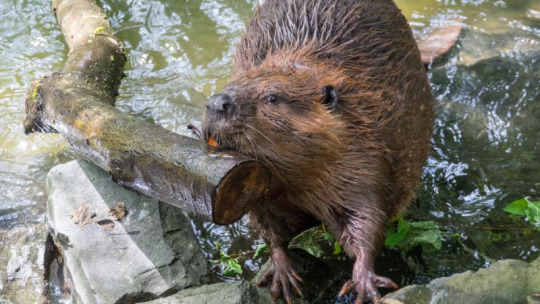
(Image ID: a beaver seen from the front on some rocks by the water's edge. It is dragging a long log in its mouth. Its top incisors are visible and orange. End ID)
The North American beaver is found in most of Canada and the United States, as well as northern Mexico while the Eurasian beaver's natural range has been considerably reduced from what it once was. They now live in portions of western, central, and eastern Europe, west Russia, and Scandinavia, with isolated populations in Mongolia and northwest China. Beavers live in freshwater (and occasionally brackish water) streams and lakes. They are nocturnal and crepuscular, active most commonly between dusk and dawn. Beavers are generalist herbivores, eating a variety of leaves, stems, shoots, roots, and bark. They prefer herby food in summer and woody food in winter. Beavers form stores of food underwater for the winter. Their digestive systems have an enlarged portion of the intestine called a caecum that helps digest the cellulose form all the plants and wood they eat. Their feces has been reported to have sawdust in it. Beavers are territorial and mark their territory with smell using secretions from their anal and castor glands that are placed onto piles of rock and mud they build. beavers defend their territories fiercely and will get into fights with others trying to move into their territory. Beavers who live in neighboring territories will gradually grow less aggressive toward each other and they become used to each other's scent. This is called the dear enemy effect and is seen in other territorial species. Beavers communicate using a variety of noises including whines and growls. A common behavior is slapping the tail against the surface of the water, which is used to alert other beavers to danger.
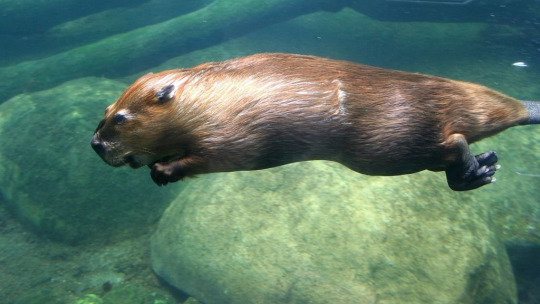
(Image ID: a beaver swimming underwater. Its body is strengthened out and streamlines. Its front legs are tucked under its chin. The hind legs are being used for swimming. The tail is out of frame. There are rocks and logs in the background. End ID)
Beavers require deep and still water to build their homes, but they aren't satisfied just looking for lakes to live in. No, these little entrepreneurs will make the conditions they need by damming streams. I will devote a whole section below to beaver damming and its impacts on the environment. Aside from dams, beavers also build lodges, which are their homes. Building these structures requires material and beavers use wood, mud, and rocks. To get the wood, they use their incisors and powerful teeth to chew through trees and branches. Famously, a beaver can take down a large tree in under a day. Lodges take a while to build, and until it is ready, beavers live in simple burrows on the water's edge. There are two types of lodges: bank lodges and open-water lodges. Bank lodges are burrows along the water's edge covered in sticks and are more common with Eurasian beavers. The more famous open-water lodges are built away from the shore. A pile of sticks forms a platform that is covered with a dome. The dome reaches above the water and is made of sticks and rocks held together with mud. Inside the dome but above the water is an open cavity filled with air. This is called the living space and is (as the name suggests) where the beavers live. The only above-water opening in the living space is an air hole built in the very top. The other entrances are underwater, meaning that beavers can only enter and leave by swimming. This provides good protection from predators, most of whom wouldn't be able to swim into the living space, as wells as insulation to keep the living space warm in winter. Beavers live in familial groups usually consisting of a pair of parents and up to eight children. Family members use the scent of their anal glands to identify each other and will body through grooming each other and play-fighting. The parents are monogamous, but will seek out new mates if they lose theirs. Mating occurs in late December to mid January when the female goes into heat. Up to four pups are born three to four months later. Beavers are born furry and with open eyes and can digest solid food after a week, but usually nurse for up to three months. Beaver milk is more fatty than the milk of other rodents. Beaver offspring will stay with their parents for two years before becoming independent and a family can have two generations of offspring at a time. The largest families need to build multiple lodges. The offspring, called kits, will stay in the lodge for their first one to two months and will start assisting the family with construction of dams and lodges at a year old. They reach sexual maturity between one and three years of age and can live for up to ten years in the wild. Beavers that become independent will travel away from their parent's pond to find a new stream or pond to settle in. This is the time most beavers meet their future mates and the pair will travel together in search of their new home. Beavers will stay in the same territory unless poor conditions force them to leave and find a new home.
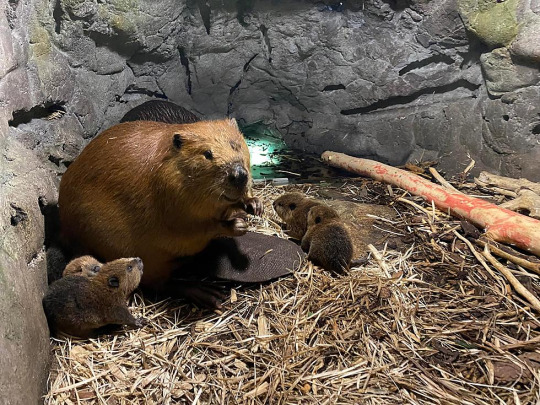
(Image ID: A beaver in the Minnesota Zoo with four kits. They are in an artifical lodge with stone walls and star and sticks on the ground. The kits are miniature versions of the adult. End ID.)

(Image ID: an artistic depiction of a beaver lodge with a cutaway to show the interior. It is a large pile of branches with a chamber inside partly submerged in the water. The chamber is connected to the outside by two tunnels the open underwater. There are two adult beavers outside the lodge and three juveniles inside. End ID. Source)
The most famous feature of beaver behavior is their dams. By damming streams, beavers create the large and still ponds they need to build their dams. Beavers that live in pre-existing ponds or lakes that are deep enough for their lodge entrances to be underwater don't need to build dams. To start, thy will dig canals to reduce the flow of the stream, then drive large logs and branches into the mud of the stream bottom to form a base. The dam is then filled in with rocks, branches, shrubs, mud, and anything else the beaver can get its paws on. Beavers can pull or carry objects up to their weight and will build canals and use mud slicks to pull larger logs. Dam complexes can cover acres of territory and the canals beavers dig dig to divert water and help move logs around can be over half a kilometer (1,600 ft) long. The largest dam in the world is in Alberta, Canada's Wood Buffalo National Park and is 775 meters (2,543 ft) long and growing. It was formed of different dams that were combined. Beavers are one of the best examples of ecosystem engineers, species that modify their habitats. They are also a keystone species that are vital in wetland areas of their native range. Dams expand wetlands and reshape the stream environment in ways that typically benefit the local ecosystem. There are some negative impact of beaver dams, including impeding fish migration, increasing silt upstream of the dam, low oxygen levels in the created ponds, and harming species that require fast flowing water. However, the positive impacts of the dams are many and varied. The dams create new ponds that provide habitat for many species that require deeper or slower water, including many aquatic insect larvae, worms, and mussels. These ponds are also ideal spawning locations for many fish and amphibian species, especially salmon and trout that can leap over the dams. Indeed, beaver dams are a huge boon to salmon spawning. The ponds also raise the local water tables and help prevent drought. The areas in and around ponds see a large increase in plant species diversity that encourages local grazing animals and migratory species to visit. Because the areas around beaver ponds are so wet, they act as natural fire breaks, helping mitigate the damage from fires. The dams also help prevent floods downstream by slowing the amount of water that passes, thus helping prevent erosion. The dams act like sieves, filtering out silt, debris, excess nitrogen, and pesticides and other chemicals that get into the water. Bacteria living in the dams break down cellulose in plant matter and release nitrogen gas into the atmosphere. On the downside, beavers have been extending their range north as the arctic warms and their ponds are melting permafrost, which releases methane into the atmosphere.

(Image ID: a beaver in a forest environment gnawing a tree. The tree trunk is slightly thicker around than the beaver. The Beaver is chewing at one side of the tree while the other side is already chewed, resulting in an hourglass shape. End ID)

(Image ID: two beavers sitting on top of their dam and working on building it. One beaver is gnawing on a log while the other one is carrying a bundle of roots in its mouth. End ID)

(Image ID: a beaver dam seen from above. The dam is a large pile of sticks, longs, rocks, and mud that stretches across a stream. The water level on one side of the dam is significantly higher than on the other side. End ID.)
Both species of beaver as currently classified as Least Concern by the IUCN, meaning they are not at risk of extinction. This was not always the case. Beavers have historically been heavily trapped for their meat, fur, and castoreum. The castoreum was used in many forms of medicine. Nowadays it isn't used anymore except in homeopathy and other forms of quackery. The fur trade vastly reduced beaver populations and it was only due to new laws and conservation efforts that the two species were saved from extinction. Since then conservation efforts have largely revolved around trapping beavers and reintroducing them to new areas. Probably the most famous example of this is the 1948 beaver drop, when the Idaho Department of Fish and Game dropped beavers in crates from planes, where they parachuted to the ground and were released. Despite how silly this sounds, it had a much higher survival rate than other relocation methods. Only one of the 76 beavers died due to forcing its way out of the crate during the drop and falling to its death. Beavers can damage infrastructure by damming streams near human activity and can damage trees people want to keep alive. There are ways of mitigating this. Pipes can be used to keep the water levels of the ponds from getting too high and fences or other deterrents around trees keep the beavers from cutting them down. If the beavers are causing too much of a problem, trapping and relocating them can help. On the other hand, sometimes environmental managers trying to attract beavers will make artificial beaver dams to try to entice beavers to adopt a stream. This is sometimes done in streams with too much erosion or water that flows too fast for beavers to settle. The artificial dams start the work and set things up for beavers either relocated to the stream or that pass by and settle down. Beavers are used as symbols of hard work, industry, and families. The beaver is the national animal of Canada. If Canada appreciates the beaver, shouldn't you too?
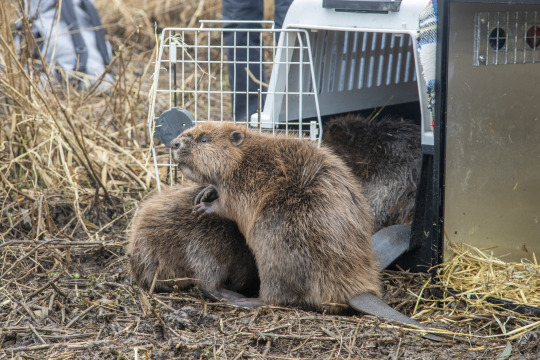
(Image ID: a group of three beavers being released from a crate. End ID)
youtube
(Video ID: archive footage of the 1948 beaver drop. End ID)
#wet beast wednesday#beaver#rodent#mammal#beaver dam#beaver lodge#biology#zoology#ecology#freshwater ecology#animal facts#long post#educational#image described#Youtube
52 notes
·
View notes
Text
Excerpt from this story from Hakai Magazine:
When I was a teenager, my parents bought a home near an old farm pond in Bangor, Maine. A family of muskrats lived there and would go about their business as I lazed on the dock; I didn’t pay them close attention, as they were hardly glamorous creatures, and in retrospect, I took them for granted. Nevertheless, I did appreciate their presence. On warm-season evenings, the football-sized rodents—they resemble enormous voles or small, long-tailed beavers—would chug back and forth, harvesting cattails and carrying fronds to their den to eat in privacy. The sight of a whiskered nose held just above the water, a small bow wave preceding it, never ceased to lift my spirits.
When I learned last summer that muskrats as a species are struggling, the news came as a sad surprise, though the decline has been decades in the making. In the 1990s and early 2000s, around the same time as I met my farm-pond neighbors, the number of muskrats caught for their fur by trappers in the eastern United States and Canada started to drop, in some places precipitously. Wildlife managers typically use trapping data to track muskrat populations, but since the popularity of trapping had also dwindled, that seemed a likelier explanation for the downward trend than an actual population decline: after all, muskrats are known for their resilience.
They are prolific breeders, raising a dozen or more young per year in times of plenty, as happy and quick to set up house along a drainage ditch as in a wetland sanctuary. Even as other so-called furbearers were trapped to near-oblivion in the 19th and early 20th centuries, muskrats flourished, and they persisted through the thoughtless times before the adoption of federal clean water laws and the advent of environmental agencies in the United States and Canada. They’re the sort of species for whom the International Union for Conservation of Nature’s formal designation of “least concern” has seemed quite appropriate. Impervious would be another term.
Yet, reports of declines continued to gather from throughout their native range, which runs from the Arctic Circle to the US–Mexico border. In 2017, biologists Adam Ahlers of Kansas State University and Edward Heske at the University of Illinois Urbana-Champaign published the most comprehensive analysis to date, confirming that the patterns did not seem to be a function of trapping statistics. Something else was going on—and whatever it was, it was big. Since the early 1970s, muskrat populations appeared to have fallen by at least one-half in 34 US states. In a handful of states, the collapse was near-total, coming in between 90 and 99 percent.
Muskrats remain fairly common overall—no official population count exists, but it’s safe to ballpark within the millions throughout their range—and in some places, they still thrive, with as many lodges per wetland hectare as there are homes in a leafy suburban subdivision; researchers don’t fear their extinction, but the overall trend is deeply troubling. It is also mysterious. Many possible causes exist, from climate change to habitat fragmentation to vegetation shifts to disease, but “no one has really proposed a reason that seems like the most likely one,” says John Crockett, a wildlife ecologist and PhD candidate at the University of Rhode Island, where he is monitoring the Ocean State’s muskrats. “It’s just a muddle of different possible culprits.”
3 notes
·
View notes
Text
Preliminaries

Information about contestants below!
Nutria or coypu (Myocastor coypus)
Nutria is a large, herbivorous, semiaquatic rodent. It lives in burrows alongside stretches of water and feeds on river plant stems. It somewhat resembles a very large rat, or a beaver with a small, long and skinny hairless tail. Three distinguishing features are a white patch on the muzzle, webbed hind feet, and large, bright orange-yellow incisors.
Nutria are found most commonly in freshwater marshes and wetlands. They either construct their own burrows, or occupy burrows abandoned by other animals. They are also capable of constructing floating rafts out of vegetation. Nutria live in partially underwater dens. One male will share a den with three or four females and their offspring.
Nutria can live up to six years in captivity, but individuals uncommonly live past three years old. It is considered an invasive species in Europe.
Desmarest's hutia or Cuban hutia (Capromys pilorides)
It is the largest living hutia. It has thick, coarse fur which extends to the tip of the tail. The colour of the body fur varies from black to brown, with a light sand colour and red also seen.
The Desmarest's hutia is found only in Cuba, but is widespread throughout its range. In northern Cuba, populations tend to be centred on areas where there are abundant mangroves, while southern populations tend to favour a more terrestrial habitat.
Desmarest's hutias normally live in pairs, but can be found individually or in small groups. They are diurnal and do not burrow, so during the night they rest in hollows in rocks or trees. They are omnivorous but eat mostly bark, leaves and fruit. In captivity they live for eight to eleven years.
Muskrat (Ondatra zibethicus)
They are covered with short, thick fur of medium to dark brown color. They have long tails covered with scales. To aid in swimming, their tails are slightly flattened vertically, a shape that is unique to them. Muskrats spend most of their time in the water and can swim underwater for 12 to 17 minutes.
The muskrat mostly inhabit wetlands. They live in families, consisting of a male and female pair and their young. They build nests that are often burrowed into the bank with an underwater entrance. Muskrats feed mostly on cattail and other aquatic vegetation but also eat small animals.
Their bodies, like those of seals and whales, are less sensitive to the buildup of carbon dioxide than those of most other mammals. They can close off their ears to keep water out. In some European countries the muskrat is considered an invasive species.
20 notes
·
View notes
Text
Warrior Cats Prefixes List- B
I had a WC Name Generator on Perchance that I made but I don't seem to have access anymore, so I'm remaking it here as just a simple list. The definitions used are the ones that Clan cats have for those things, and thus are the origins of the names. Definitions used are whatever I found when I googled it.
Badger-: "[noun] a heavily built omnivorous nocturnal mammal of the weasel family, typically having a gray and black coat"
Balsam-: "[noun] a herbaceous plant cultivated for its flowers, which are typically pink or purple and carried high on the stem"
Barberry-: "[noun] a thorny shrub that bears yellow flowers and red or blue-black berries"
Bark-: "[noun] an outer layer of a woody plant such as a tree or stick; [noun] the sharp explosive cry of certain animals, especially a dog, fox, or seal"
Barley-: "[noun] a hardy cereal that has coarse bristles extending from the ears"
Basalt-: "[noun] a dark, fine-grained volcanic rock that sometimes displays a columnar structure"
Basil-: "[noun] an aromatic annual herb of the mint family; [noun] the leaves of the basil plant"
Bass-: "[noun] any of numerous edible marine or freshwater bony fishes"
Bat-: "[noun] any of a widely distributed order of nocturnal flying mammals that have wings formed from four elongated digits of the forelimb covered by a cutaneous membrane and rely on echolocation"
Bay-: "[noun] a broad inlet of the sea where the land curves inward; [noun] an indentation or recess in a range of hills or mountains; [noun] an evergreen shrub of the laurel family with deep green leaves and purple berries"
Bayberry-: "[noun] a North American shrub with aromatic leathery leaves and waxy berries"
Beach-: "[noun] a strip of land covered with sand, pebbles, or small stones at the edge of a body of water"
Bear-: "[noun] a large, heavy mammal that walks on the soles of its feet, having thick fur and a very short tail"
Beaver-: "[noun] a large semiaquatic broad-tailed rodent that is native to North America and northern Eurasia"
Bee-: "[noun] a honeybee; [noun] an insect of a large group to which the honeybee belongs, including many solitary as well as social kinds"
Beech-: "[noun] a large tree with smooth gray bark, glossy leaves, and hard, pale, fine-grained timber"
Beetle-: "[noun] an insect of an order distinguished by forewings typically modified into hard wing cases that cover and protect the hind wings and abdomen"
Begonia-: "[noun] a herbaceous plant of warm climates, the flowers of which have brightly colored sepals but no petals"
Belladonna-: "[noun] another name for the deadly nightshade plant"
Bellflower-: "[noun] a plant with bell-shaped flowers that are usually blue, purple, pink, or white"
Bergamot-: "[noun] a round to pear-shaped citrus fruit of a Mediterranean tree that has a yellow to green rind which yields a bitter, fragrant essential oil and that is typically considered to be a hybrid of a sour orange and a lemon; [noun] the tree that bears the bergamot fruit"
Berry-: "[noun] a small roundish juicy fruit without a stone"
Betta-: "[noun] a small bright-colored fish, the males of which fight vigorously"
Big-: "[adj] of considerable size, extent, or intensity"
Bilberry-: "[noun] a small dark blue edible berry; [noun] a hardy dwarf shrub closely related to the blueberry, with red drooping flowers and dark blue edible berries"
Billow-: "[noun] a large undulating mass of something, typically cloud, smoke, or steam; [verb] fill with air and swell outward"
Billowing-: "[adj] filled with air and swelling outward; [adj] (of smoke, cloud, or steam) moving or flowing outward with an undulating motion"
Birch-: "[noun] a slender, fast-growing tree that has thin bark (often peeling) and bears catkins"
Bird-: "[noun] a warm-blooded egg-laying vertebrate distinguished by the possession of feathers, wings, and a beak and (typically) by being able to fly"
Bison-: "[noun] a humpbacked shaggy-haired wild ox native to North America and Europe"
Bitter-: "[adj] having a sharp, pungent taste or smell; not sweet"
Bittern-: "[noun] any of various small or medium-sized, short-necked, usually secretive herons"
Black-: "[noun] black color or pigment; [adj] of the very darkest color owing to the absence of or complete absorption of light; the opposite of white"
Blackberry-: "[noun] an edible soft fruit consisting of a cluster of soft purple-black drupelets; [noun] the prickly climbing shrub of the rose family that bears blackberries"
Blackbird-: "[noun] a European thrush with mainly black plumage; [noun] an American bird with a strong pointed bill. The male has black plumage that is iridescent or has patches of red or yellow"
Blackthorn-: "[noun] a thorny Eurasian shrub that bears white flowers before the leaves appear and astringent blue-black fruits"
Blade-: "[noun] one of the elongated linear leaves of a typical grass"
Blaze-: "[noun] a very large or fiercely burning fire; [verb] burn fiercely or brightly"
Blazing-: "[verb] burn fiercely or brightly"
Blight-: "[noun] a plant disease, typically one caused by fungi such as mildews, rusts, and smuts (smut as defined as a fungal disease of grains); [verb] infect (plants) with blight"
Blizzard-: "[noun] a severe snowstorm with high winds and low visibility"
Bloodroot-: "[noun] a North American plant of the poppy family, which has white flowers and fleshy underground rhizomes which exude red sap when cut"
Bloom-: "[noun] a flower, especially one cultivated for its beauty; [noun] a delicate powdery surface deposit on certain fresh fruits, leaves, or stems; [verb] to produce flowers, to be in flower"
Blossom-: "[noun] a flower or a mass of flowers, especially on a tree or bush; [verb] (of a tree or bush) produce flowers or masses of flowers"
Blotch-: "[noun] an irregular patch or patches on a surface, typically the fur"
Blotched-: "[adj] covered with blotches"
Blue-: "[noun] blue color or pigment; [adj] of a color intermediate between green and violet, as of the sky or sea on a sunny day"
Bluebell-: "[noun] a European woodland plant of the lily family that produces clusters of blue bell-shaped flowers in spring; [noun] any of a number of other plants with blue bell-shaped flowers"
Blueberry-: "[noun] the small sweet blue-black edible berry of the blueberry plant; [noun] a hardy dwarf shrub of the heath family, with small, whitish drooping flowers and dark blue edible berries"
Bluebird-: "[noun] an American songbird of the thrush subfamily, the male of which has a blue head, back, and wings"
Boa-: "[noun] a constrictor snake which bears live young and may reach great size, native to America, Africa, Asia, and some Pacific islands"
Boar-: "[noun] a tusked Eurasian wild pig from which domestic pigs are descended; [noun] a male domestic pig"
Bog-: "[noun] wet muddy ground too soft to support a heavy body"
Bold-: "[adj] (of a person, action, or idea) showing an ability to take risks; confident and courageous"
Bolete-: "[noun] a mushroom or toadstool with pores rather than gills on the underside of the cap"
Bolt-: "[verb] (of an animal) run away suddenly out of control; [noun] thunderbolt"
Bone-: "[noun] any of the pieces of hard whitish tissue making up the skeleton in vertebrates; [noun] the calcified material of which bones consist"
Borage-: "[noun] a herbaceous plant with bright blue flowers and hairy leaves"
Boulder-: "[noun] a large rock, typically one that has been worn smooth by erosion"
Bounce-: "[noun] an act of jumping or an instance of being moved up and down; [verb] (of a person) jump repeatedly up and down, typically on something springy"
Bough-: "[noun] a main branch of a tree"
Bracken-: "[noun] a tall fern with coarse lobed fronds, which occurs worldwide and can cover large areas"
Bramble-: "[noun] a prickly scrambling vine or shrub, especially a blackberry or other wild shrub of the rose family"
Brambling-: "[noun] a small brightly-colored passerine bird in the finch family"
Branch-: "[noun] a part of a tree which grows out from the trunk or from a bough"
Brave-: "[adj] ready to face and endure danger or pain; showing courage"
Bream-: "[noun] a greenish-bronze deep-bodied freshwater fish native to Europe"
Breeze-: "[noun] a gentle wind"
Briar-: "[noun] any of a number of prickly scrambling shrubs, especially the sweetbriar and other wild roses"
Bright-: "[adj] giving out or reflecting a lot of light, shining; [adj] (of a person) intelligent and quick-witted"
Brindle-: "[noun] a brownish or tawny color of animal fur, with streaks of other color; [adj] (especially of domestic animals) brownish or tawny with streaks of other color"
Brine-: "[noun] the water of a sea or salt lake"
Bristle-: "[noun] a short stiff hair, typically one of those on an animal's skin, a man's face, or a plant; [verb] (of hair or fur) stand upright away from the skin, especially in anger or fear"
Brittle-: "[adj] hard but liable to break or shatter easily"
Brittlegill-: "[noun] another name for the Russula genus of mushrooms"
Broken-: "[adj] having been fractured or damaged and no longer in one piece or in working order; [adj] (of a person) having given up all hope, despairing"
Bronze-: "[noun] a yellowish-brown alloy of copper with up to one-third tin; [noun] a yellowish-brown color"
Brook-: "[noun] a small stream"
Broom-: "[noun] a flowering shrub with long, thin green stems and small or few leaves, cultivated for its profusion of flowers"
Brown-: "[noun] brown color or pigment; [adj] of a color produced by mixing red, yellow, and blue, as of dark wood or rich soil"
Brush-: "[noun] a plant community characterized by vegetation dominated by shrubs, often also including grasses, herbs, and geophytes"
Bryony-: "[noun] a climbing plant that has greenish-white flowers and red berries"
Bubble-: "[noun] a thin sphere of liquid enclosing air or another gas"
Bud-: "[noun] a compact growth on a plant that develops into a leaf, flower, or shoot"
Buffalo-: "[noun] a heavily built wild ox with backswept horns, found mainly in the Old World tropics"
Bug-: "[noun] an insect of a large order distinguished by having mouthparts that are modified for piercing and sucking; [noun] a small insect"
Bull-: "[noun] a fully grown male animal of a domesticated breed of ox"
Bumble-: "[verb] move or act in an awkward or confused manner; [verb] speak in a confused or indistinct way"
Bumblebee-: "[noun] a large hairy bee with a loud hum, living in small colonies in holes underground"
Bunny-: "[noun] a rabbit, especially a young one"
Bunting-: "[noun] any of several types of small singing bird with a short, wide, pointed beak and brightly colored feathers on the male bird, found in North and South America"
Burdock-: "[noun] a large herbaceous Old World plant of the daisy family"
Burn-: "[verb] (of a fire) produce flames and heat while consuming a material such as coal or wood; [verb] destroy, damage, or injure by heat or fire"
Burnet-: "[noun] a herbaceous plant of the rose family, with globular pinkish flower heads and leaves composed of many small leaflets"
Burnt-: "[adj] of or showing colors having a deeper or grayer hue than is usually associated with them"
Burr-: "[noun] a seed or dry fruit or infructescence that has hooks or teeth"
Burrow-: "[noun] a hole or tunnel dug by a small animal, especially a rabbit, as a dwelling; [verb] (of an animal) make a hole or tunnel, typically for use as a dwelling"
Buttercup-: "[noun] a poisonous herbaceous plant with bright yellow cup-shaped flowers, which is common in grasslands and as a garden weed"
Butterfly-: "[noun] a nectar-feeding insect with two pairs of large, typically brightly colored wings that are covered with microscopic scales"
Buzz-: "[noun] a low, continuous humming or murmuring sound, made by or similar to that made by an insect"
Buzzard-: "[noun] a large hawklike bird of prey with broad wings and a rounded tail, typically seen soaring in wide circles"
4 notes
·
View notes
Note
My HTF-sona would be a nutria, also known as the coypu. It’s a species of semiaquatic rodent native to South America that have been introduced to other parts of the world as an invasive species.
cool
3 notes
·
View notes
Text
Hangin' out with my buddy on a sunny day
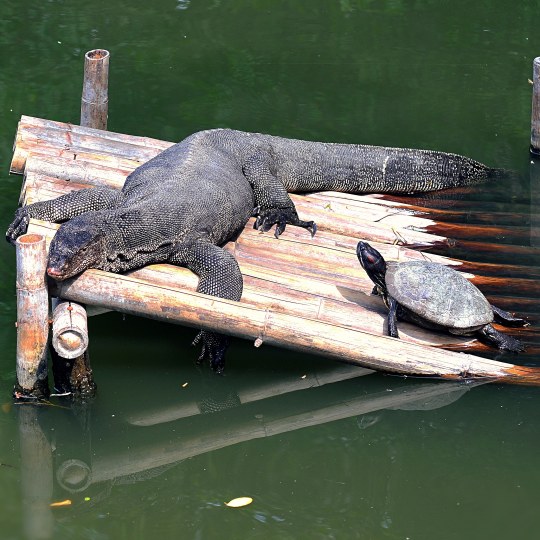
Come on, we all have a that friend that really is half dragon and a bit scary, but still nice to hang out with on a hot day.
This couple really did not much out of the day. The Turtle kept his toes in the water, and as I was walking by several times, the large Water Monitor only changed the position of his snout. Something smelly, but not interesting enough to do something else.
Opportunistic and wide spread
The Asian water monitor (Varanus salvator) is a large varanid lizard native to Southeast and South Asia. It is common from the coastal eastern India, Bangladesh and Sri Lanka, Mainland SEA, southern China and Indonesia.
The monitors is highly opportunistic when choosing habitats, and it is semiaquatic. Meaning they are able to live near or in human habitats were there easy access to large water sources. Like Bangkok in Thailand, were I have seen several of theses varanids near the many rivers and channels in that city. Not very large ones, but maybe just under a meter length including their tails.

Moving and smelling the air, crossing the giraffe compound in Dusit Zoo. This one appx 80 cm long.
These animals reach breeding maturity when they are about 40 cm long and a weight of 1 kilo for males, and 50 cm for females. They normally grows up to 2 meter, but there are one specimen in Sri Lanka which reached 3,21 meter. The weight is a moderate appx 20 kg. But the max weight is over 50 kilo.
Their size and weight is second only to the Komodo Dragon lizards.
They are top-level predators, only natural enemies are crocodiles and humans. They eat a huge variation of food, from fish and rodents to human garbage and domesticated cats and dogs. They are not considered a direct danger for humans, but they may bite if cornered. Varanid bites are filled with oral bacterias that can lead to serious infections. And some of the variants may have venom glands.
Edible and skinned
It is an edible animal, hunted and served as a delicious source of protein in several South East Asian cuisines and in India. Globally, their skins are traded in millions for different type of leatherware products. It is not considered threaten. But habitats are threaten by loss and fragmentation.
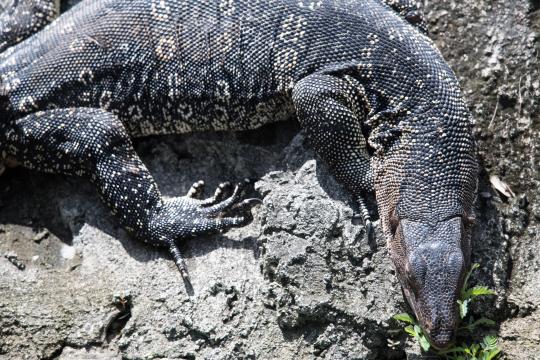
No idea of a possible future as shoes and handbags.
The Red eared slider Terrapin turtle are not native to South East Asia at all, it origins in North America in Southeast around Mississippi and Gulf of Mexico. It is consider one of the worst invasive species in the world, being spread as a pet release or escapees. They are spread all over the Eurasian continent, from Scotland and Russia to South east Asia, the Pacific and Zealandia.
#bangkokzoo#lostplaces#thaifood#turtle#asiancuisine#2014#Asian#water#monitor#varanus#salvator#2014CE#bangkok#thailand#lastchancetosee#dusit#zoo#dusitzoo#animalphotography#citylife#citywalk#art#market#buddhism#bluesky
4 notes
·
View notes
Text
For the Love of a Lizard
Some interesting lizards in the world Asian Water Monitors are large varanid lizards. They’re native to South and Southeast Asia. These are among the most common monitor lizards in Asia. Asian Water Monitors are semiaquatic and are great swimmers. They have powerful legs and claws to climb trees to escape predators. They’re carnivores and their diet consists of fish, frogs, rodents, birds,…

View On WordPress
0 notes
Text
No, that's Nutella. Neutrogena is a large herbivores semiaquatic rodent from South America.
You know, these new apocalypse prophecies just don't carry a punch. 'Oooo, the illuminati is going to perform a mass human sacrifice under the guise of the eclipse.' Big deal. 'Oooo, the path of the eclipse lines up with the seven cities of Neutrogena and when the sun is covered then everyone that got vaccinated is going to turn into a zombie.' I'm so scared.
Bring back 'huge fucking wolf eats the sun.' That's a classic that never gets old.
2K notes
·
View notes
Text
CZECH REPUBLIC: Firefighters float trapped beaver out of concrete cylinder
Firefighters were called out to help a beaver that found itself trapped at the bottom of a concrete cylinder in Frýdek-Místek, in the Moravian-Silesian Region of the Czech Republic. In a post, the local fire service said they were contacted by a concerned resident who spotted the beaver and assumed it was resting. When they returned the next day to find the semiaquatic rodent still there, they…

View On WordPress
0 notes
Text
April 7 Is International Beaver Day 🦫
International Beaver🦫 Day is celebrated annually on April 7. The holiday was created in 2009 by Beavers Wetlands & Wildlife (B.W.W.,) a non-profit organization with members in the United States, Canada, and other countries. Beavers are a unique and important keystone species, having a great impact on the ecosystem. Since 1985, B.W.W. has made big strides in research and education with the intention to create awareness about the little dam-builders known as beavers.
International Beaver Day was created in 2009 by Beavers Wetlands & Wildlife (B.W.W.). April 7 was chosen as the date for the holiday because it marks the birthday of Dorothy Richards — popularly known as the ‘Beaver 🦫 Woman’ — who was born in 1894. Richards engaged in the study of beavers for 50 years of her life.
The word ‘beaver’ derived its origin from the Old English word ‘beofor,’ meaning ‘brown’ or ‘bright.’ Beavers are semiaquatic rodents found in the temperate Northern Hemisphere in countries like Canada, Poland, Germany, France, central Russia, and southern Scandinavia, among others. They are the second-largest semi-aquatic rodents on earth, second only to capybaras. They typically live in freshwater environments, such as rivers, lakes, streams, and ponds. Beavers have large heads, stout bodies, and brown or gray fur, with hand-like front feet and back feet that are webbed.
Beavers 🦫 are a keystone species, meaning that they have a disproportionately large effect on the environment in comparisoto their number. Beavers make good use of the trees they eat by building dams and lodges with the leftover parts of it, also transporting other materials such as mud, rocks, and debris. Because they were often hunted for their fur and meat, beavers nearly became extinct in the 19th and early 20th centuries. Though there were reported to be about 60 million beavers in North America at one time, their population has dropped to around 10 to 15 million.
Please Take Very Good Care Of These Hardworking Animals Of The Riverbanks Who Taught Humans How To Make Dams Of Our Own & Being The Original Construction Workers Of Nature Itself 🦫
Happy International Beaver 🦫 Day

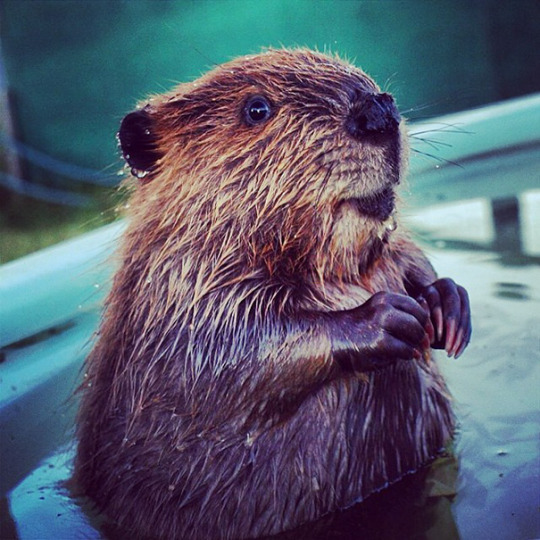
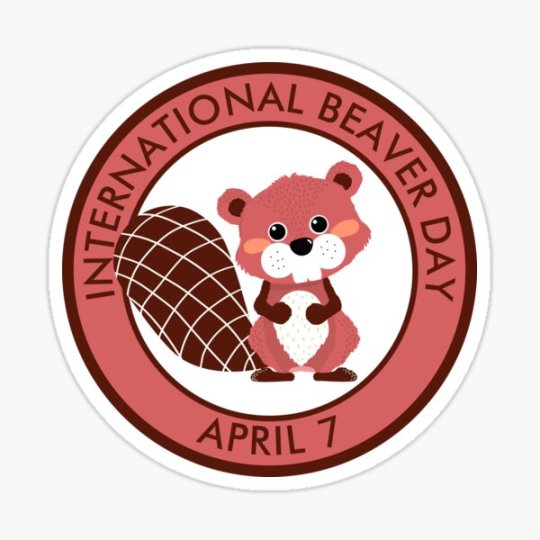
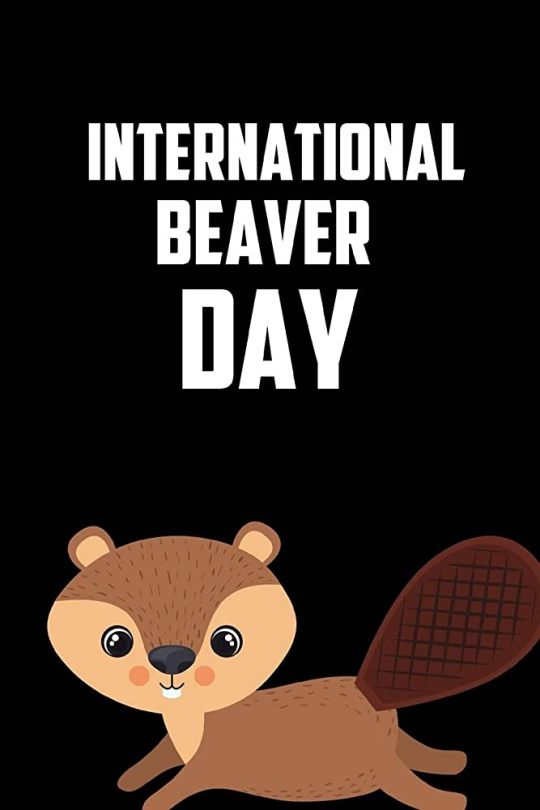
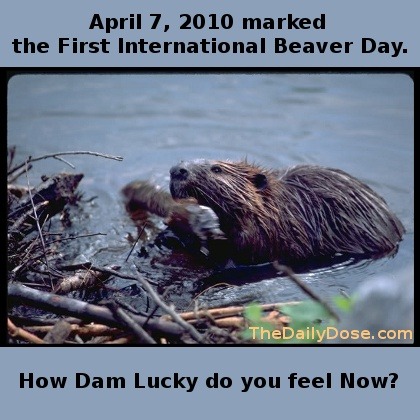
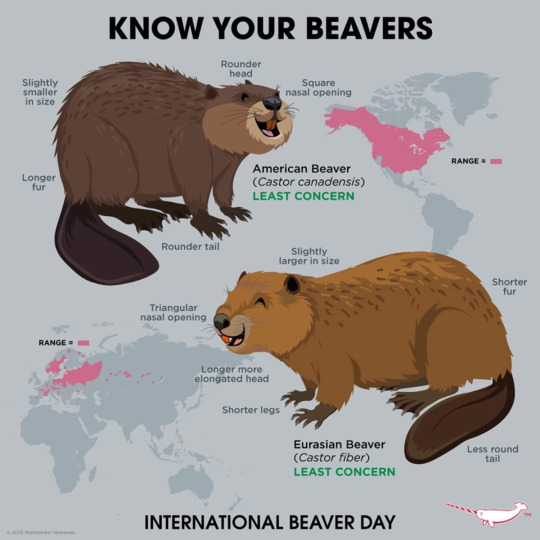
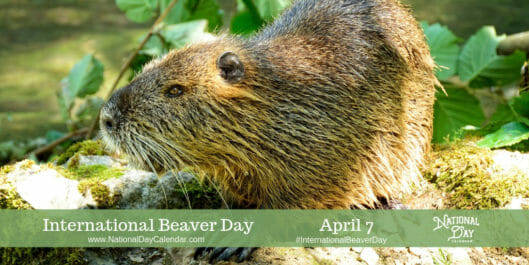
1 note
·
View note